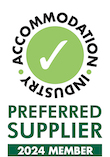How To Set a Table with Cutlery: Formal, Informal and Casual
“When a guest sits down there should be something beautiful and inspiring to look at.” - Annie Falk
A table set with cutlery is a beautiful and inspiring sight to behold. It makes a difference no matter how simple or elaborate a meal is.
But setting a table with cutlery is an art. There are rules to follow when it comes to arranging the cutlery, plates and glasses. With all these rules it can be a little nerve-wracking to set a table. Luckily, you can learn this art.
Stick around and we will show you how to set a table with ease.
To a large extent, the type of occasion you have will determine how you will set your table. Your occasion will generally fall in either of these three categories.
- Basic setting
- Formal setting
- Informal setting
Let’s look at how to set your table for each of these occasions.
Basic Table Setting
This method is quite common and suitable for restaurant meals such as dinner or lunch.
You will need
- dinner plates,
- cutlery; forks, knives, and spoons,
- drinking glasses
- table napkins.
How to Set the Table
- Position the dinner plate at the centre of the place setting. Then place everything else around it.
- On the left of the plate place the fork.
- On the right of the plate place the knife and spoon. The sharp edges of the knife should face toward the plate. If the main course is meat, then use a steak knife instead of a dinner knife.
- On the right of the knife place the spoon.
- The drinking glass goes above the knife.
- You can fold the napkin. Or, put it into a napkin ring and place it either to the left of the fork, under the fork, or on the dinner plate.
You'll need napkins that are durable and versatile. Australian Linen Supply has superior quality and durable napkins.
If you forget what goes where when setting the table, use the acronym FOrKS to remember the placing order. From left to right start with:
F - Fork
O - for the shape of the plate
K - Knife
S - Spoon
Formal Table Setting
Formal dinners are often characterised by formal attire, dinner setting, and perfect arrangements. Usually, during a formal dinner, many courses will be served.
A formal setting will include:
- a serving plate, also known as a charger,
- forks; a salad fork and dinner fork,
- knives; a dinner and salad knife,
- spoons; a soup and dinner spoon,
- bread plate and a butter knife, above the forks,
- glasses; a water glass, a white, and red wine glass.
Steps to Set The Table
|
|
|
|
|
|
|
- Place a serving plate, also known as a charger, in the centre of the place setting. This is the underplate for courses that precede the entree.
- Flowers, candlesticks or decorative centrepieces should be placed to the top of the charger.
- On the left of the plate place the dinner fork. The salad fork goes next to the dinner fork because you will have the salad before the main course. Always ensure that the fork prongs are facing upwards.
- On the right of the plate place the dinner knife, followed by the salad knife. The sharp edge of the knife should always face the plate.
- If you are serving soup and desert then place the soup spoon next to the salad knife. The dessert spoon goes to the top of the plate with a handle to the right. Place the dessert fork next to the dessert spoon with a handle to the left. That way, you can slide down the dessert fork and spoon when it’s time for dessert.
- The dinner plate goes on top of the charger.
- Place the bread plate at the left corner of the charger with a butter knife on top, slanted at an angle.
- The drinking glass should be to the right of the place setting, above the table knife.
- Fold your napkin and place it to the left of the forks or under the forks. You can also fold it and place it on top of the dinner plate for that fancy look.
White linen tablecloth isn’t essential for a formal dinner party, but you can’t go wrong with one. Australian Linen Supply has durable and coloured linen. You can also use linen that blends with your beautiful centrepieces.
As a rule of thumb, always begin eating with the outermost silverware first working your way in towards the centre.
Informal Table Setting
This setting is casual and so allows you to be more creative with your placements.
Unlike a formal setting, there is an assumption that the meals in an informal setting can be served on one plate. So, you will use less silverware compared to a formal setting.
Examples of informal settings include brunch or luncheon.
In this setting, you need:
- napkins,
- cutlery; forks, knives and spoons,
- bread plates,
- drinking glasses.
Steps To Set The Table
- Fold your napkin and place in a wine glass.
- Place your dinner plate at the centre of the table.
- Forks go to the left of the plate.
- The bread plate is placed to the left above the forks.
- Spoons are placed to the right of the knives.
- At the top right of the dinner plate above knives and spoons, place the drinking glass.
- The bread plate is placed on the left of the place setting next to the fork.
Five Important Tips
- Whether you are setting a formal or informal table, the basic placement of the cutlery is the same. The knives and spoons are on the right of the plate while the forks always go to the left.
- Knife blades should always face in toward the plate, while fork tines face upwards.
- When clearing the table after meals, start with the cutlery from the right of the guest. This is a universal industry standard.
- When serving wine hold the wine glass by the stem and not by the bowl. This minimises fingerprints on the glass.
- Always set the table with only the utensils that will be used for the meal. For instance, if you are serving red wine only, do not place white wine glasses on the table.
You are now an expert at setting a table with cutlery for basic, formal and informal occasions. Now it's over to you to impress your restaurant guests with impeccable table settings!
For all your high-quality, affordable food and beverage linen, check out Australian Linen Supply today!
Feature Image: Pexels by Kaboompics.com















